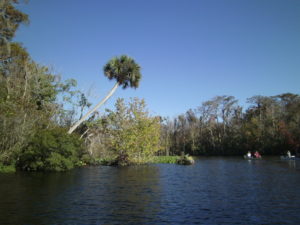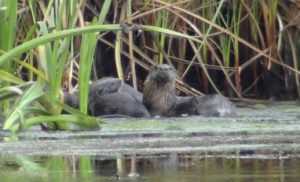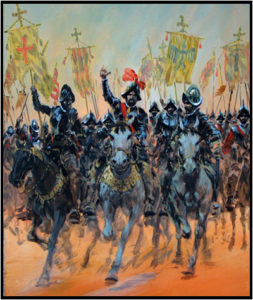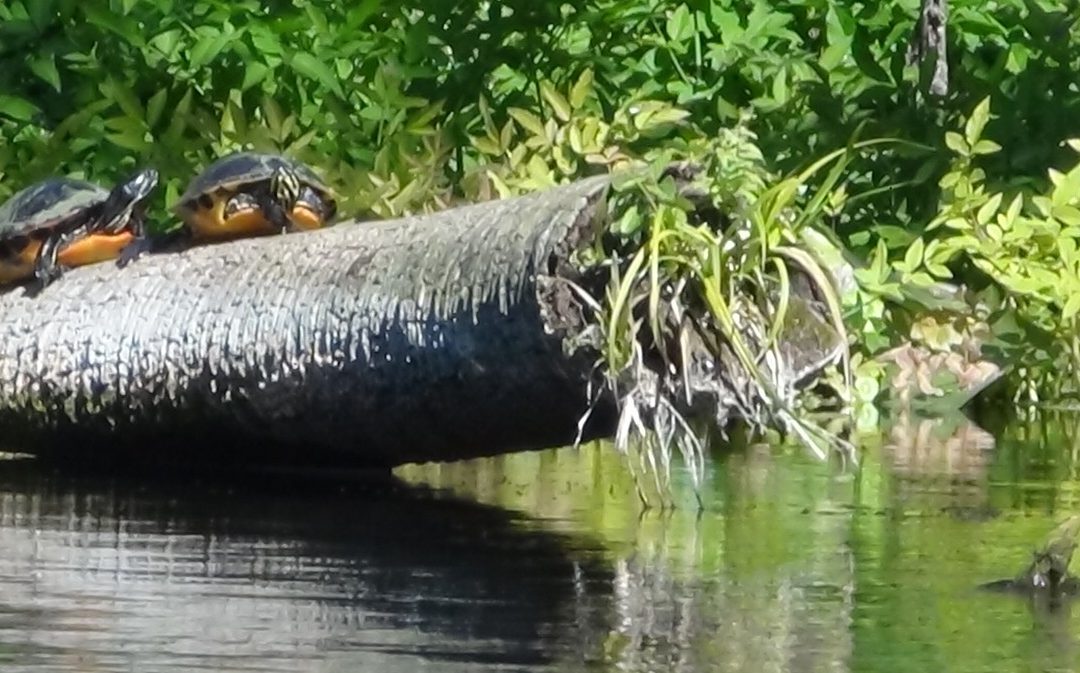Bear Creek Guided canoe and kayak trip
Group size: 1 – 24 people
Trip length: 5 – 5.5 hours
Skill level: Intermediate
Cost
Most guided tours are $50 per person. (includes boat, paddle, vest, shuttling and your guide)
Using your Own Boat – $40. (many paddlers with their own boats like to join us to learn more about the history, archaeology and natural history of these rivers).
Dates
Join a scheduled tour (see tour calendar ), or suggest one. Find a free date on the calendar and suggest the trip of your choice. If there are no conflicts, we’ll post it!
OR
Schedule a private tour. Use contact form, email us at riverguide2000@yahoo.com or call (386-454-0611)
Location
Check the River Locator Map or Click the link below for a local map and then use zoom and panning arrows to explore the area. (Note: the marker is NOT our meeting place, but a nearby landmark.
Local Map
Description
This remote little stream offers a great opportunity to explore the wild beauty of a swamp without getting wet (usually).
On this exploration, we follow a maze of creeks and sloughs as they braid through the backwaters of the lower Ocklawaha basin. The first leg of our journey follows Bear Creek and Indian Village Slough into the heart of the swamp. Much of this section lies within Little Lake George Wilderness Area. Cypress, tupelo, maple, cabbage palm, holly, swamp dogwood and variety of wetland trees form a closed canopy overhead. In their soft shadows, we are immersed in the sights, sounds and smells of the regal bottom land forest.
 After a couple of hours paddling, we emerge from this shaded serenity onto a wide bend of St. Johns River. Here we rest, drifting in floating gardens of spatter dock, water lettuce, water hyacinth, duckweed and water ferns as we enjoy lunch and watch the hustle of myriad river-craft of all shapes and sizes working the storied river. We also watch for some of the many species of birds that live along the big river and, perhaps, a passing manatee. After our brief siesta–fed, fluffy, and rejuvenated, we resume our trip. We enter the mouth of the Ocklawaha.
After a couple of hours paddling, we emerge from this shaded serenity onto a wide bend of St. Johns River. Here we rest, drifting in floating gardens of spatter dock, water lettuce, water hyacinth, duckweed and water ferns as we enjoy lunch and watch the hustle of myriad river-craft of all shapes and sizes working the storied river. We also watch for some of the many species of birds that live along the big river and, perhaps, a passing manatee. After our brief siesta–fed, fluffy, and rejuvenated, we resume our trip. We enter the mouth of the Ocklawaha.
This part of the Ocklawaha starts out wide as we make our way upstream against a modest current. Soon, we succumb to the lure of the swamp and turn off the wide channel to reenter the river swamp. Following a series of narrow water-trails, with names like Turpentine and Tusintak Creeks, we pass through a section of Caravelle Ranch Wildlife Management Area before rejoining the main channel and the last leg of our journey back to the launch site. This is a round trip.
 Wildlife
Wildlife
Florida’s swamps, in general, offer a virtual smorgasbord (are my Danish roots showing?) of wildlife. Ocklawaha’s river-swamp is a prime example. The year-round abundance of woodland birds swells considerably in winter with arriving migrants. Manatees are a possibility near St. Johns river. Other wild residents include bears, eagles, osprey, deer, otters, egrets, herons, ibis and other water birds. This section also has a healthy ‘gator population, as well as snakes and an occasional wild hog. We often see wading birds, ranging from lone limpkins to 100+ flocks of white ibis feeding among the cypress knees and buttressed trunks of ash, tupelo and oak.
History
Remains of an ancient Indian village site and a nearby shell mound on high ground south of Indian Village Slough attest to prehistoric occupation dating back nearly 14,000 years. By the time Europeans arrived, this was the realm of the Acuera, one of dozens of Chiefdoms that made up the Timucua linguistic group which stretched from Orlando north to central Georgia.
 The first Europeans to encounter the Acura were Spanish soldiers under the command of Hernando de Soto. The Spaniard’s encounter with the Ocklawaha natives was brief but memorable. When the Indians refused to meet with them, the soldiers sicked their war mastiff on them. The dog obeyed his command and swam the river to attack the Indiana. By the time he reached the other side of the river, he looked more porcupine than dog, with over 40 arrows sticking out of his body. He died at the Indians feet and the Spaniards turned and left.
The first Europeans to encounter the Acura were Spanish soldiers under the command of Hernando de Soto. The Spaniard’s encounter with the Ocklawaha natives was brief but memorable. When the Indians refused to meet with them, the soldiers sicked their war mastiff on them. The dog obeyed his command and swam the river to attack the Indiana. By the time he reached the other side of the river, he looked more porcupine than dog, with over 40 arrows sticking out of his body. He died at the Indians feet and the Spaniards turned and left.
Beginning in the mid-1800’s, steamboats began plying the waters of Ocklawaha. The first landing up from the St. Johns was on the banks of Bear Creek. After the Civil War, steam-boating increased and their cargo changed. No longer vessels of basic commerce, they were increasingly carrying tourists. The first taste of wild Florida that our State’s first ecotourists experienced were here, in the forests of Bear Creek and the lower Ocklawaha River.
As it turned out, the heyday of Ocklawaha’s steamboat era (the late 1800’s into the early 1900’s) was also the height
of activity and settlement on the river. Flanked by a broad swath of dense hardwood swamps and river forests, this part of the river has successfully kept civilization at bay. Today, this is the exclusive realm of fishermen and paddlers. Adventurers looking for wild Florida at its best will love this tour. (For more on the Ocklawaha’s past, see the Ocklawaha River tour listing).
Difficulty
This streams slow, easy flow makes it suitable for paddlers of all skill levels. The main consideration is your endurance. We are usually on the water for 5 – 5.5 hours. There are no restrooms or facilities of any kind. In fact, there is little dry ground in the adjacent forests, so people who need frequent restroom breaks will probably want to pass on this one. Pull-overs and short wades are a possibility. There are a few tricky forks on all of the side canals and on the Ocklawaha itself so you won’t want to get too far away from the guide.


